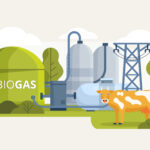Introduction: In a world urgently seeking sustainable energy solutions, biogas emerges as a powerful and environmentally friendly alternative. Derived from organic matter, biogas offers a host of benefits that make it a game-changer in the quest for clean energy. In this blog post, we’ll delve into the intricacies of biogas, exploring its production process, environmental advantages, and its potential to transform our energy landscape.
Biogas Production Process:
At its core, biogas is a gaseous fuel produced through the anaerobic digestion of organic materials. The process can be broken down into several key steps:
Feedstock Selection: Biogas can be generated from a wide range of organic materials, including agricultural residues, food waste, sewage sludge, and more. The choice of feedstock depends on availability and local conditions.
Digestion: The selected organic material is placed in an anaerobic digester, a sealed container where microorganisms break down the feedstock in the absence of oxygen. This process produces biogas as a byproduct.
Biogas Capture: Biogas, primarily composed of methane (CH4) and carbon dioxide (CO2), is captured and collected from the digester. It can then be purified to remove impurities.
Utilization: The purified biogas can be used for various applications, such as electricity generation, heating, and even as a vehicle fuel. The residual material left after digestion, known as digestate, is rich in nutrients and can be used as a natural fertilizer.
Environmental Advantages:
Reduced Greenhouse Gas Emissions: Biogas production helps mitigate climate change by capturing methane, a potent greenhouse gas, that would otherwise be released into the atmosphere during the decomposition of organic matter.
Waste Diversion: Biogas systems divert organic waste from landfills, reducing methane emissions and preventing the pollution of groundwater from leachate.
Soil Enrichment: The nutrient-rich digestate can improve soil fertility and structure when used as a fertilizer, contributing to sustainable agriculture.
Potential for Transformation:
Biogas has the potential to revolutionize our energy landscape in several ways:
Sustainable Electricity Generation: Biogas can be used to produce electricity, which can help meet the energy demands of communities, industries, and even entire regions.
Energy Independence: By utilizing locally available organic materials, biogas projects can enhance energy security and reduce reliance on fossil fuels.
Waste-to-Wealth: Biogas projects offer opportunities for revenue generation through the sale of surplus electricity, digestate, and carbon credits.
Conclusion: Biogas is more than just a sustainable energy solution; it’s a catalyst for positive environmental and societal change. By harnessing the power of organic matter, we can reduce greenhouse gas emissions, minimize waste, and create a cleaner, more resilient energy future. As we continue to explore and invest in biogas technology, we move one step closer to a more sustainable and eco-conscious world. The time to unleash the power of biogas is now.




